ANR-12-BSV5-0003, coordination and contact Patrick Berthault – LSDRM.
This ambitious project aims at proposing the combined use of hyperpolarized 129Xe NMR, micro-fluidics and micro-coils as an ultra sensitive biosensing tool for diagnosis purposes.
Objectives and means
The final objective of this project is to integrate all developments and discoveries in an NMR lab-on-chip type system of general applicability for various in vitro biological diagnoses on commercial NMR spectrometers.
- Two main properties of the noble gas will be used:
- the extraordinary receptiveness of xenon to its local environment in terms of NMR parameters and particularly chemical shift.
- the huge gain in sensitivity afforded by the hyperpolarization


- The detection threshold will be further significantly lowered through conception of a stopped-flow setup associated with rf micro-coils. This will extend the detection level beyond the femtomole, i. e. several orders of magnitude better than what is achieved by other magnetic resonance techniques. The micro-fluidics and micro-coils will be obtained by printing methods and the different parts will be assembled.
Three laboratories are working together at the forefront of their respective research domains:
- LSDRM, CEA : Responsible of the NMR and MRI experiments with hyperpolarized xenon
- LCSI, CEA : Develop innovative processes of chemical writing on polymer substrates or printing microfluidics, and therefore can build detection coils on flexible substrates and fluidics by printing techniques without clean room facilities.
- Laboratoire de Chimie, ENS Lyon: Organic chemist specialists of the cryptophanes, ideal hosts for hyperpolarized xenon in molecular imaging applications.
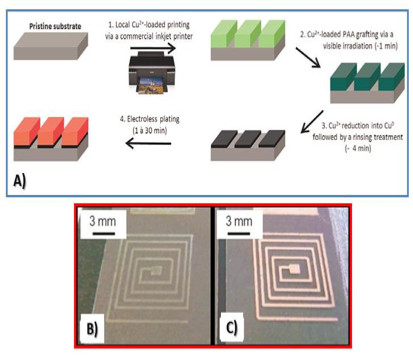
Applications
- Xenon with biological cell suspensions. The specific spectral signature of xenon in the inner compartment of living cells will give access to precious structural and morphological information such as plasma membrane permeability, an important property for cancer cell studies.
- Encapsulated xenon. Dedicated xenon host molecules will be functionalized in order to enable detection of specific biological events. Encapsulation of xenon in such host systems will deeply modify its resonance frequency and therefore further improve the detection capability.
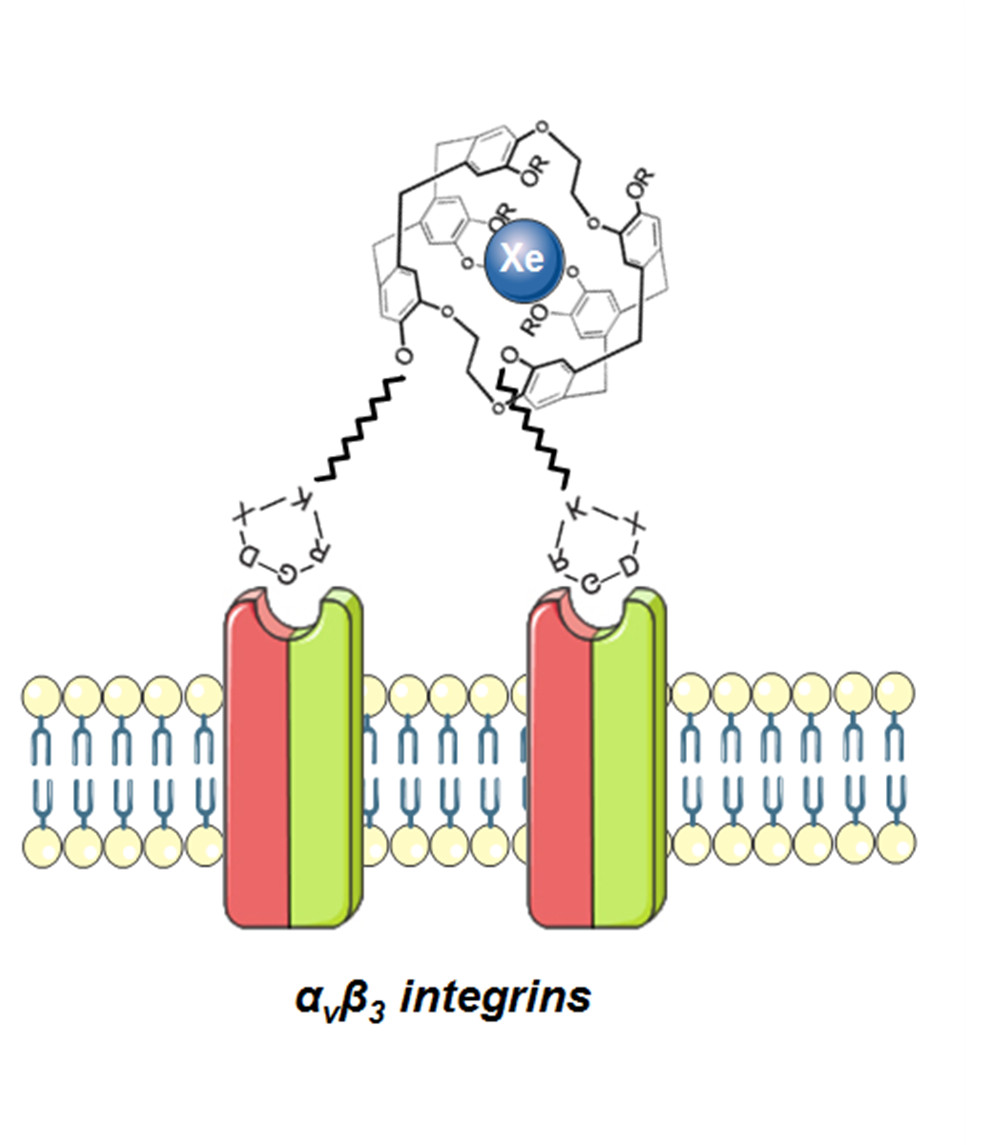
Example of xenon biosensor targeting the integrin receptors
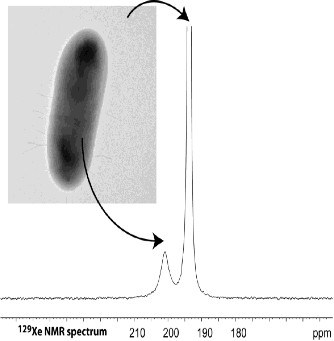
Results and News
-
January 2013: Publication of “Polymer Grafting by Inklet Printing: A Direct Chemical Writing Toolset” in Advanced Functional Materials
Among all the patterning techniques, inkjet printing has lately become a reliable technique at micrometer scale to produce localized modifications on material surfaces. Printing of polymer on material surface however leads to adsorbed patterns with poor adhesion. To overcome this drawback, a new process combining for the first time inkjet printing and an efficient covalent polymer grafting method was developed. This latter method is based on a photo-assisted reduction of aryldiazonium salt/acrylate monomer ink, derived from the already published GraftFast™ process. In order to demonstrate its versatility, this new localized polymer grafting process is here combined as an example with the ligand induced electroless plating (LIEP) process to obtain metal interconnects onto flexible and transparent substrates with excellent mechanical and electrical properties for applications in flexible electronics devices. Printed copper interconnects on PET film by the inkjet process.
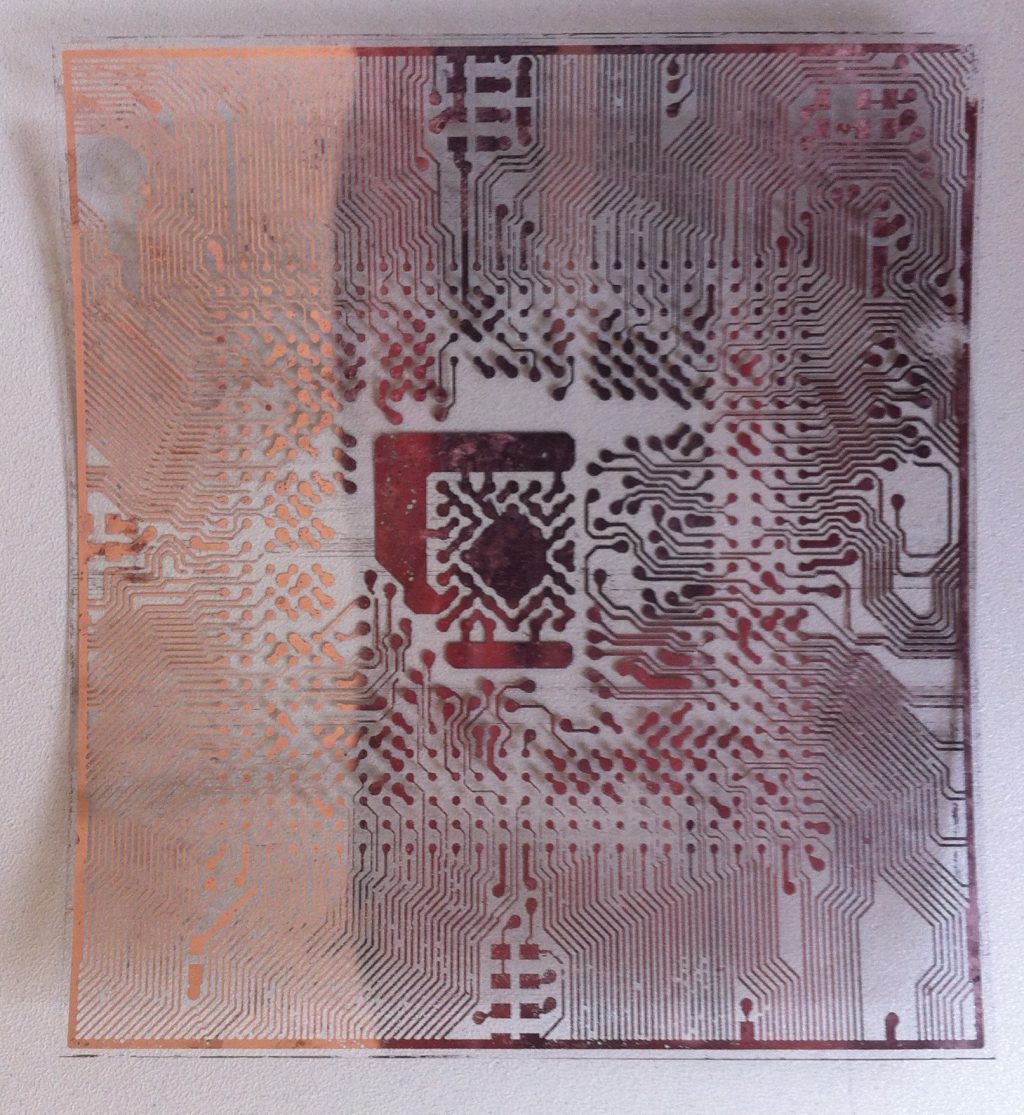
-
April 2013: Arrival of the Dimatix printer.
-
May 2013: Dr. Alexandre Causier joins us in a Post-doctoral position
After a thesis at UVSQ (Versailles and St-Quentin-en-Yvelines University) in the Institut Lavoisier, he joins the Max4us team in order to develop micro-coils and microfluidics.
-
June 2013: Conception, design and tests of the first NMR microfluidic prototype!
For sake of simplicity, we have firstly decided to conceive and build fluidic incorporating micro-coils of solenoid shape, to be plugged on the micro-imaging probe of our narrow-bore 11.7 T spectrometer. The fluidic parts were digitally drawn, obtained by laser cutting printer and assembled with the micro-solenoid to obtain the first NMR microfluidic prototype. They are connected to the electric circuit of the probe, which enables us to tune and match them via the usual way.

-
November 2013, Publication of our work: Ultrafast Z‑Spectroscopy for 129Xe NMR-Based Sensors, J. Phys. Chem. Lett. 4 (2013) 4172-4176. DOI: 10.1021/jz402261h
When working with hyperpolarized species, it is often difficult to maintain a stable level of magnetization between successive experiments. We have proposed a method using spatially-encoded saturation in a chemical exchange saturation transfer (HyperCEST) experiment* for detecting the presence of bound xenon and measuring the xenon exchange in one scan.
This method allows us to lower by a factor of 10 the threshold of detectable cells. It will be easily combined with the use of micro-coils to further lower the detection threshold.
* The exchange between xenon in the biosensor (small reservoir) and in the bulk (large reservoir) enables indirect detection of the biosensor on the bulk xenon signal after saturation at the caged xenon frequency.
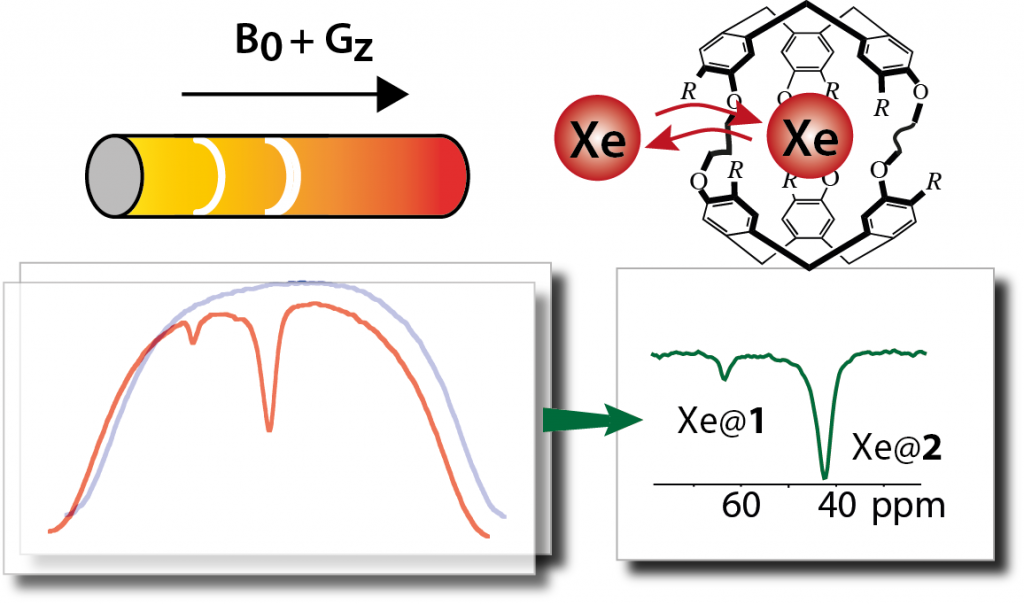
-
January 2014:
- The first planar coils have been built by inkjet process and electroless copper plating
- The 3D printer is here !
- Publication of our work:
Smart Detection of Toxic Metal Ions, Pb2+ and Cd2+, Using a 129Xe NMR-Based Sensor, Anal. Chem. 86 (2014) 1783−1788.
N. Tassali, N. Kotera, C. Boutin, E. Léonce, Y. Boulard, B. Rousseau, E. Dubost, F. Taran, T. Brotin, J.-P. Dutasta, and P. Berthault
An approach for sensitive magnetic resonance detection of metal cations is proposed. Combining the use of hyper polarized 129Xe NMR and of a cage-molecule functionalized by a ligand able to chelate different cations, we show that simultaneous detection of lead, zinc, and cadmium ions at nanomolar concentration is possible in short time, thanks to fast MRI sequences based on the HyperCEST scheme.
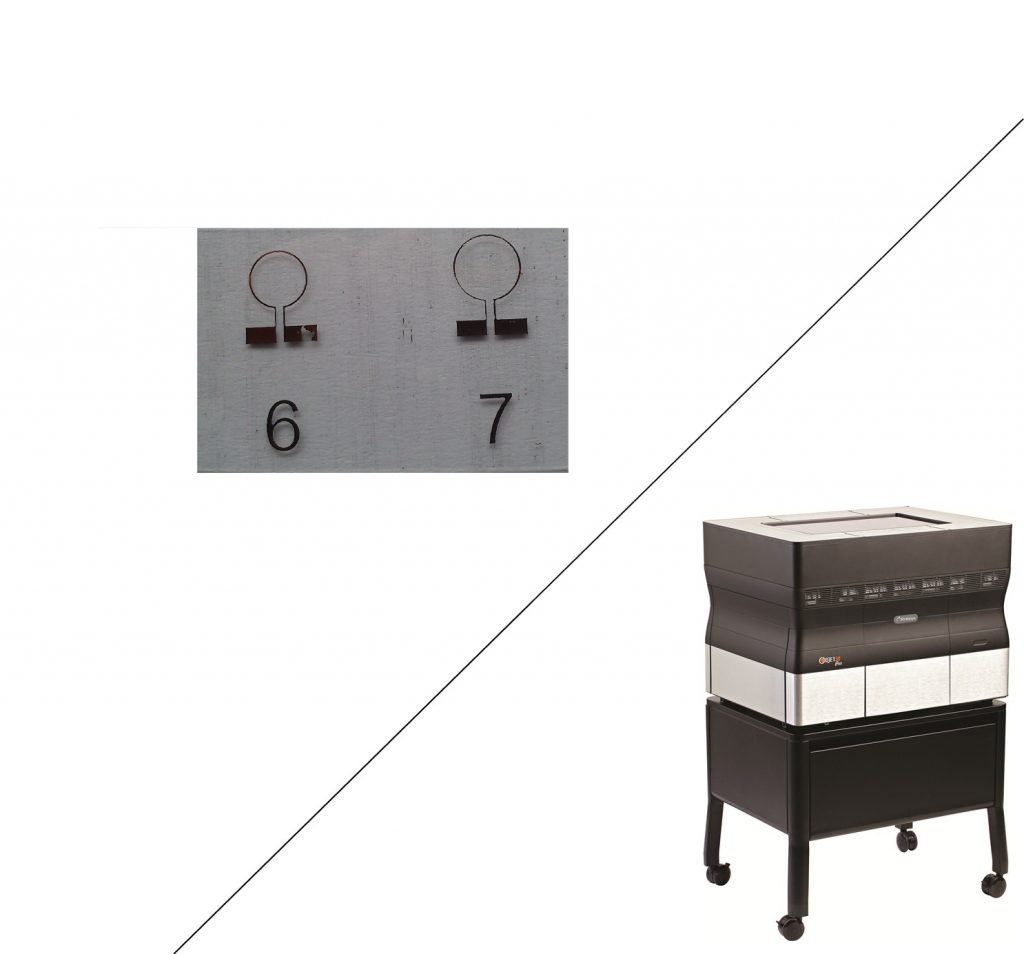
-
October 2014:
- The principle of a bubble micropump ensuring dissolution of hyperpolarized xenon and flow of the solution of interest loaded by the noble gas has been patented (French Patent #14 62890)
-
March 2015, Publication of our work:
3D-printed system optimizing dissolution of hyperpolarized gaseous species for micro-sized NMR, Lab-on-a-Chip (2015) DOI : 10.1039/C5LC00193E
Dissolution of hyperpolarized species in liquids of interest for NMR is often hampered by the presence of bubbles that degrade the field homogeneity. Here a low-cost device constituted by a bubble pump and a miniaturized NMR cell fitting both inside the narrow bore of an NMR magnet is built by 3D printing. 129Xe NMR experiments performed with hyperpolarized xenon reveal high and homogeneous dissolution of the gas in water.
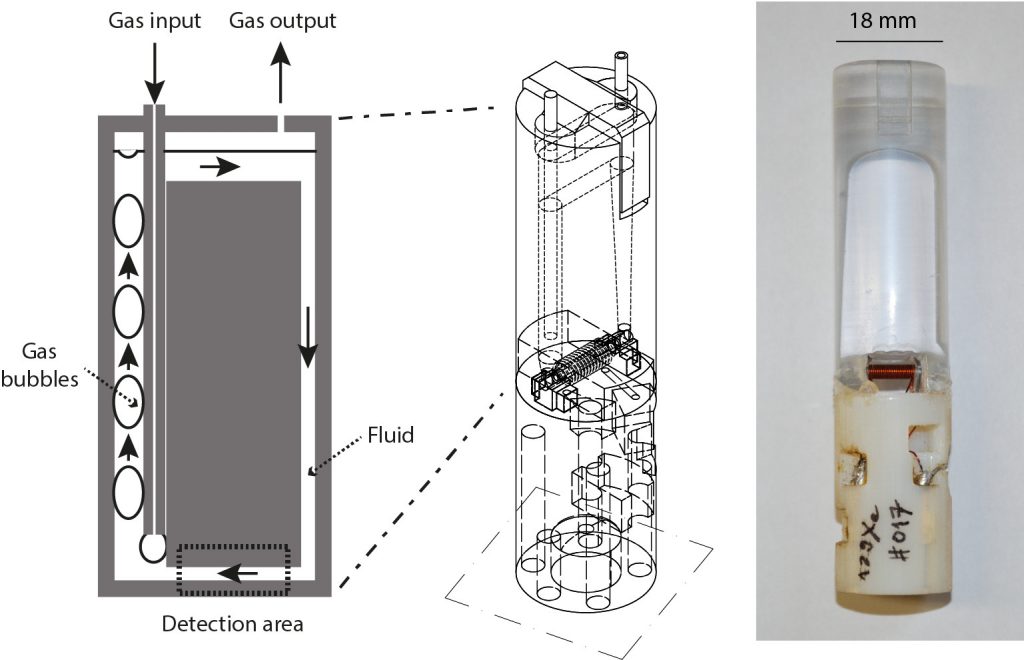
-
June 2015, Publication of our work:
Synthesis of Cryptophanes With Two Different Reaction Sites: Chemical Platforms for Xenon Biosensing, J. Org. Chem. (2015) DOI: 10.1021/acs.joc.5b00653
In this article we describe the synthesis of new water-soluble cryptophane host molecules that can be used for the preparation of 129Xe NMR-based biosensors. The cryptophane-223 skeleton has been modified in order to introduce a unique secondary alcohol to the propylenedioxy linker. This chemical functionality can then be exploited to introduce a functional group different from the six chemical groups attached to the aromatic rings. In this approach the generation of a statistical mixture when trying to selectively functionalize a symmetrical host molecule is eliminated, which enables the efficient large-scale production of new cryptophanes that can be used as chemical platforms ready to use for the preparation of xenon biosensors. To illustrate this approach several molecular platforms have been prepared. The ability of these new derivatives to bind xenon has also been investigated.
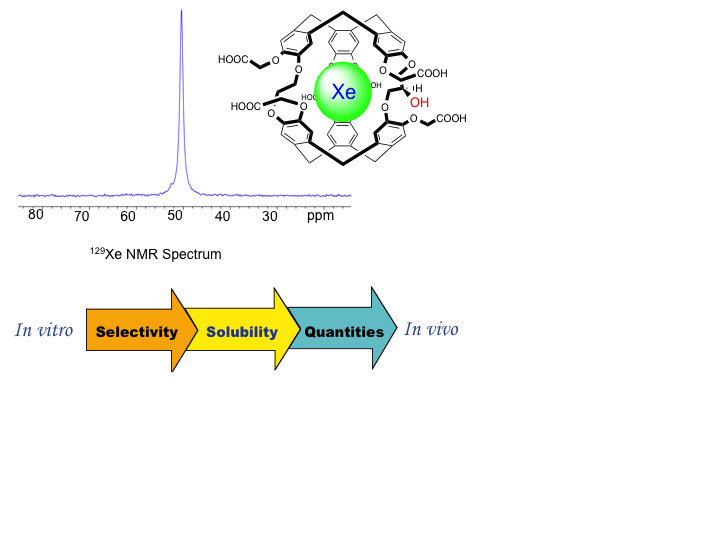
-
June 2015, Publication of our work:
A doubly responsive probe for the detection of Cys4-tagged proteins, Chem. Comm. (2015) DOI: 10.1039/c5cc04721h
In this article we report the first example of the design and synthesis of a dual fluorescence and hyperpolarized 129Xe NMR-based sensor of Cys4-tagged proteins. This sensor becomes fluorescent when bound to such Cys4-tagged peptides, and the 129Xe NMR spectrum exhibits a specific signal, characteristic of the biosensor-peptide association.
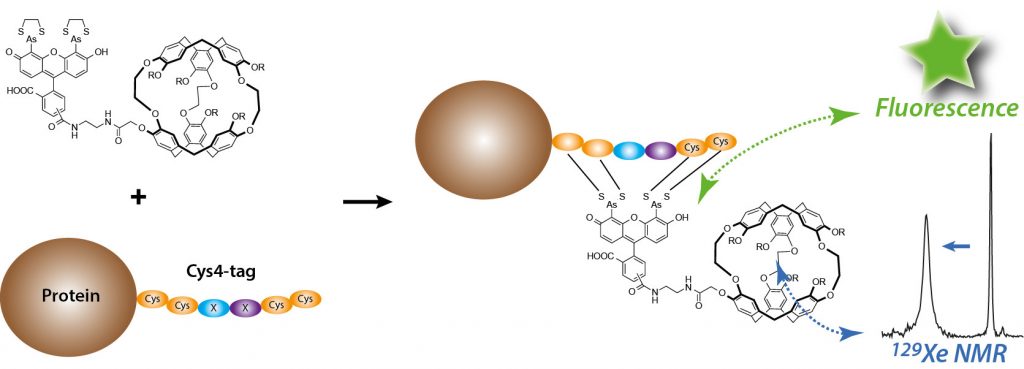
-
2016: We have decided to assess our 3D-printed device for the NMR study slowly-relaxing nuclei.
Circulation of the sample in a closed-loop circuit combined to microsized detection can lead to a significant signal NMR enhancement. The optimized NMR device based on a mini bubblepump associated with fluidics and microdetection can be installed on a commercial NMR spectrometer in this purpose. In addition to a significant signal enhancement for slowly relaxing nuclei, we have shown that it enables more precise and frequent monitoring of chemical reactions. An additional modification leads to a stopped-flow system very efficient for instance for 2D NMR experiments with long mixing times.
This work has led to a publication :
Enhancing NMR of Nonrelaxing Species Using a Controlled Flow Motion and a Miniaturized Circuit (2017) DOI: 10.1021/acs.analchem.6b04488
-
March 2017, new device combining inductively-coupled micro-coil and flow.
A device is proposed to enhance the NMR sensitivity of slowly-relaxing nuclei, taking advantage of a controlled solution flow within a microfluidic circuit and micro-sized NMR detection. This set-up can be easily installed on any commercial NMR probehead as it uses induction between the commercial antenna and the micro-coil. Such a system leads to a significant gain in sensitivity per time unit for slowly relaxing nuclei while preserving the capabilities of the host probehead.
– Patent under embargo
– Manuscript submitted
-
Fall 2017: this approach and these devices have interested a company, CortecNet, with which an ANR project LABCOM is started.






